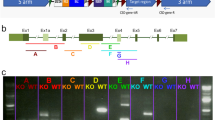Abstract
In NSE-Hu-Bcl-2 transgenic mice, line 71, retina undergoes early postnatal degeneration linked to the prior death of Müller cells. The purpose of this study was to complete the characterization of this retinal dysfunction by using electroretinographic (ERG) recordings in both scotopic and photopic conditions. Here, we showed that both rod and cone systems were profoundly affected in NSE-Hu-Bcl-2 transgenic mice as soon as 15 postnatal days in accordance with histological study performed previously.





Similar content being viewed by others
Abbreviations
- cds/m2 :
-
Candelas*second/m2
- ERG:
-
Electroretinography
- IT:
-
Implicit time
- MCs:
-
Müller glial cells
- NSE-Hu-Bcl-2 mouse:
-
Mouse over-expressing the human Bcl-2 under the control of neuron-specific enolase promotor
- OPs:
-
Oscillatory potentials
- PN:
-
Postnatal day
- WT:
-
Wild-type
- tg:
-
Transgenic
References
Kawasaki A, Otori Y, Barnstable CJ (2000) Müller cell protection of rat retinal ganglion cells from glutamate and nitric oxide neurotoxicity. Invest Ophthalmol Vis Sci 41:3444–3450
Reichenbach A, Fuchs U, Kasper M, el Hifnawi E, Eckstein AK (1995) Hepatic retinopathy: morphological features of retinal glial (Müller) cells accompanying hepatic failure. Acta Neuropathol (Berl) 90:273–281
Maw MA, Kennedy B, Knight A, Bridges R, Roth KE, Mani EJ, Mukkadan JK, Nancarrow D, Crabb JW, Denton MJ (1997) Mutation of the gene encoding cellular retinaldehyde-binding protein in autosomal recessive retinitis pigmentosa. Nat Genet 17:198–200
Morimura H, Berson EL, Dryja TP (1999) Recessive mutations in the RLBP1 gene encoding cellular retinaldehyde-binding protein in a form of retinitis punctata albescens. Invest Ophthalmol Vis Sci 40:1000–1004
Saari JC, Crabb JW (2005) Focus on molecules: cellular retinaldehyde-binding protein (CRALBP). Exp Eye Res 81:245–246
Bringmann A, Reichenbach A (2001) Role of Müller cells in retinal degenerations. Front Biosci 6:E72–E92
Bringmann A, Pannicke T, Grosche J, Francke M, Wiedemann P, Skatchkov SN, Osborne NN, Reichenbach A (2006) Müller cells in the healthy and diseased retina. Prog Retin Eye Res 25:397–424
Li Q, Puro DG (2002) Diabetes-induced dysfunction of the glutamate transporter in retinal Müller cells. Invest Ophthalmol Vis Sci 43:3109–3116
Lieth E, Barber AJ, Xu B, Dice C, Ratz MJ, Tanase D, Strother JM (1998) Glial reactivity and impaired glutamate metabolism in short-term experimental diabetic retinopathy. Penn State Retina Research Group. Diabetes 47:815–820
Rungger-Brändle E, Dosso AA, Leuenberger PM (2000) Glial reactivity, an early feature of diabetic retinopathy. Invest Ophthalmol Vis Sci 41:1971–1980
Martinou JC, Dubois-Dauphin M, Staple JK, Rodriguez I, Frankowski H, Missotten M, Albertini P, Talabot D, Catsicas S, Pietra C (1994) Overexpression of BCL-2 in transgenic mice protects neurons from naturally occurring cell death and experimental ischemia. Neuron 13:1017–1030
Dubois-Dauphin M, Poitry-Yamate C, de Bilbao F, Julliard AK, Jourdan F, Donati G (2000) Early postnatal Müller cell death leads to retinal but not optic nerve degeneration in NSE-Hu-Bcl-2 transgenic mice. Neuroscience 95:9–21
Bonaventure N, Karli P (1968) Maturation of ERG and evoked visual potentials in mice. C R Seances Soc Biol Fil 162:553–555
el Azazi M, Wachtmeister L (1990) The postnatal development of the oscillatory potentials of the electroretinogram. I. Basic characteristics. Acta Ophthalmol (Copenh) 68:401–409
Lyubarsky AL, Pugh EN Jr (1996) Recovery phase of the murine rod photoresponse reconstructed from electroretinographic recordings. J Neurosci 16:563–571
Wachtmeister L (1998) Oscillatory potentials in the retina: what do they reveal. Prog Retin Eye Res 17:485–521
Jaissle GB, May CA, Reinhard J, Kohler K, Fauser S, Lutjen-Drecoll E, Zrenner E, Seeliger MW (2001) Evaluation of the rhodopsin knockout mouse as a model of pure cone function. Invest Ophthalmol Vis Sci 42:506–513
Peachey NS, Goto Y, al Ubaidi MR, Naash MI (1993) Properties of the mouse cone-mediated electroretinogram during light adaptation. Neurosci Lett 162:9–11
Fulton AB, Hansen RM, Findl O (1995) The development of the rod photoresponse from dark-adapted rats. Invest Ophthalmol Vis Sci 36:1038–1045
Kainz PM, Adolph AR, Wong KY, Dowling JE (2003) Lazy eyes zebrafish mutation affects Müller glial cells, compromising photoreceptor function and causing partial blindness. J Comp Neurol 463:265–280
Peachey NS, Quiambao AB, Xu X, Pardue MT, Roveri L, McCall MA, al Ubaidi MR (2003) Loss of bipolar cells resulting from the expression of bcl-2 directed by the IRBP promoter. Exp Eye Res 77:477–483
Joseph RM, Li T (1996) Overexpression of Bcl-2 or Bcl-XL transgenes and photoreceptor degeneration. Invest Ophthalmol Vis Sci 37:2434–2446
Strettoi E, Volpini M (2002) Retinal organization in the bcl-2-overexpressing transgenic mouse. J Comp Neurol 446:1–10
Cenni MC, Bonfanti L, Martinou JC, Ratto GM, Strettoi E, Maffei L (1996) Long-term survival of retinal ganglion cells following optic nerve section in adult bcl-2 transgenic mice. Eur J Neurosci 8:1735–1745
Gianfranceschi L, Fiorentini A, Maffei L (1999) Behavioural visual acuity of wild type and bcl2 transgenic mouse. Vision Res 39:569–574
Porciatti V, Pizzorusso T, Cenni MC, Maffei L (1996) The visual response of retinal ganglion cells is not altered by optic nerve transection in transgenic mice overexpressing Bcl-2. Proc Natl Acad Sci U S A 93:14955–14959
Aknowledgements
This work was supported by the Provisu Foundation, Schmidheiny Foundation, De Reuter Foundation and Novartis Foundation grants to L.E-C.
Author information
Authors and Affiliations
Corresponding author
Rights and permissions
About this article
Cite this article
Péant, C., Dosso, A., Eder-Colli, L. et al. Functional study in NSE-Hu-Bcl-2 transgenic mice: a model for retinal diseases starting in Müller cells. Doc Ophthalmol 115, 203–209 (2007). https://doi.org/10.1007/s10633-007-9077-6
Received:
Accepted:
Published:
Issue Date:
DOI: https://doi.org/10.1007/s10633-007-9077-6




